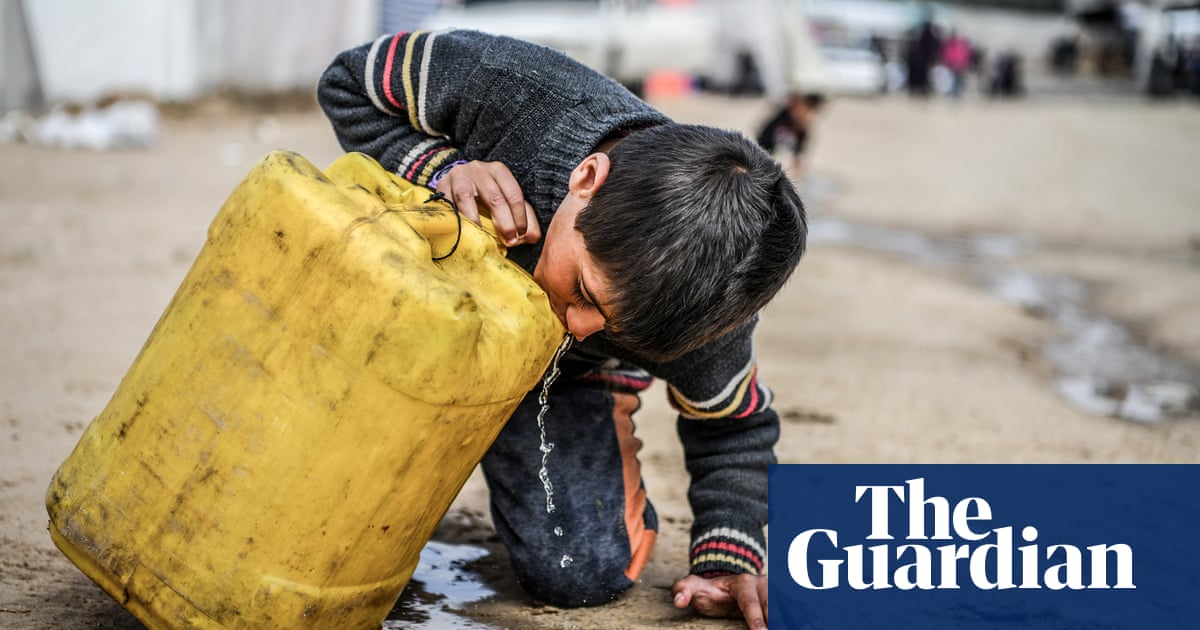World
Global water crisis leaves half of world food production at risk in next 25 years

More than half the world’s food production will be at risk of failure within the next 25 years as a rapidly accelerating water crisis grips the planet, unless urgent action is taken to conserve water resources and end the destruction of the ecosystems on which our fresh water depends, experts have warned in a landmark review.
Half the world’s population already faces water scarcity, and that number is set to rise as the climate crisis worsens, according to a report from the Global Commission on the Economics of Water published on Thursday.
Demand for fresh water will outstrip supply by 40% by the end of the decade, because the world’s water systems are being put under “unprecedented stress”, the report found.
The commission found that governments and experts have vastly underestimated the amount of water needed for people to have decent lives. While 50 to 100 litres a day are required for each person’s health and hygiene, in fact people require about 4,000 litres a day in order to have adequate nutrition and a dignified life. For most regions, that volume cannot be achieved locally, so people are dependent on trade – in food, clothing and consumer goods – to meet their needs.
Some countries benefit more than others from “green water”, which is soil moisture that is necessary for food production, as opposed to “blue water” from rivers and lakes. The report found that water moves around the world in “atmospheric rivers” which transport moisture from one region to another.
About half the world’s rainfall over land comes from healthy vegetation in ecosystems that transpires water back into the atmosphere and generates clouds that then move downwind. China and Russia are the main beneficiaries of these “atmospheric river” systems, while India and Brazil are the major exporters, as their landmass supports the flow of green water to other regions. Between 40% and 60% of the source of fresh water rainfall is generated from neighbouring land use.
“The Chinese economy depends on sustainable forest management in Ukraine, Kazakhstan and the Baltic region,” said Prof Johan Rockström, the director of the Potsdam Institute for Climate Impact Research and one of the co-chairs of the commission. “You can make the same case for Brazil supplying fresh water to Argentina. This interconnectedness just shows that we have to place fresh water in the global economy as a global common good.”
Tharman Shanmugaratnam, the president of Singapore and a co-chair of the commission, said countries must start cooperating on the management of water resources before it was too late.
“We have to think radically about how we are going to preserve the sources of fresh water, how we are going to use it far more efficiently, and how we are going to be able to have access to fresh water available to every community, including the vulnerable – in other words, how we preserve equity [between rich and poor],” Shanmugaratnam said.
The Global Commission on the Economics of Water was set up by the Netherlands in 2022, drawing on the work of dozens of leading scientists and economists, to form a comprehensive view of the state of global hydrological systems and how they are managed. Its 194-page report is the biggest global study to examine all aspects of the water crisis and suggest remedies for policymakers.
The findings were surprisingly stark, said Rockström. “Water is victim number one of the [climate crisis], the environmental changes we see now aggregating at the global level, putting the entire stability of earth’s systems at risk,” he told the Guardian. “[The climate crisis] manifests itself first and foremost in droughts and floods. When you think of heatwaves and fires, the really hard impacts are via moisture – in the case of fires, [global heating] first dries out landscapes so that they burn.”
Every 1C increase in global temperatures adds another 7% of moisture to the atmosphere, which has the effect of “powering up” the hydrological cycle far more than would happen under normal variations. The destruction of nature is also further fuelling the crisis, because cutting down forests and draining wetlands disrupts the hydrological cycle that depends on transpiration from trees and the storage of water in soils.
Harmful subsidies are also distorting the world’s water systems, and must be addressed as a priority, the experts found. More than $700bn (£540bn) of subsidies each year go to agriculture, and a high proportion of these are misdirected, encouraging farmers to use more water than they need for irrigation or in wasteful practices.
Industry also benefits – about 80% of the wastewater used by industries around the world is not recycled.
Ngozi Okonjo-Iweala, the director general of the World Trade Organization, also a co-chair of the commission, said countries must redirect the subsidies, axing harmful ones while ensuring poor people were not disadvantaged. “We must have a basket of policy tools working together if we are to get the three Es – efficiency, equity and environmental sustainability and justice. Therefore we have to couple the pricing of water with appropriate subsidies,” she said.
At present, subsidies mainly benefit those who are better off, Okonjo-Iweala added. “Industry is getting a lot of the subsidy, and richer people. So what we need are better targeted subsidies. We need to identify the poor people who really need this,” she said.
Developing countries must also be given access to the finance they need to overhaul their water systems, provide safe water and sanitation, and halt the destruction of the natural environment, the report found.
after newsletter promotion
Mariana Mazzucato, professor of economics at University College London, and a co-chair of the commission, said loans made by public sector banks to developing countries should be made conditional on water reforms. “These could be improving water conservation and the efficiency of water use, or direct investment for water-intensive industries,” she said. “[We must ensure] profits are reinvested in productive activity such as research and development around water issues.”
Water problems also had an outsized impact on women and girls, Mazzucato added. “One of our commissioners is Yvonne Aki-Sawyerr, the mayor of Freetown in Sierra Leone. She says most of the rapes and abuse of women actually happen when they’re going to fetch water,” Mazzucato said. “Child mortality, gender parity, the water collection burden, the food security burden – they’re all connected.”
Five main takeaways from the report
The world has a water crisis
More than 2 billion people lack access to safe drinking water, and 3.6 billion people – 44% of the population – lack access to safe sanitation. Every day, 1,000 children die from lack of access to safe water. Demand for fresh water is expected to outstrip its supply by 40% by the end of this decade. This crisis is worsening – without action, by 2050 water problems will shave about 8% off global GDP, with poor countries facing a 15% loss. Over half of the world’s food production comes from areas experiencing unstable trends in water availability.
There is no coordinated global effort to address this crisis
Despite the interconnectedness of global water systems there are no global governance structures for water. The UN has held only one water conference in the past 50 years, and only last month appointed a special envoy for water.
Climate breakdown is intensifying water scarcity
The impacts of the climate crisis are felt first on the world’s hydrological systems, and in some regions those systems are facing severe disruption or even collapse. Drought in the Amazon, floods across Europe and Asia, and glacier melt in mountains, which causes both flooding and droughts downstream, are all examples of the impacts of extreme weather that are likely to get worse in the near future. People’s overuse of water is also worsening the climate crisis – for instance, by draining carbon-rich peatlands and wetlands that then release carbon dioxide into the atmosphere.
Water is artificially cheap for some and too expensive for others
Subsidies to agriculture around the world often have unintended consequences for water, providing perverse incentives for farmers to over-irrigate their crops or use water wastefully. Industries also have their water use subsidised, or their pollution ignored, in many countries. Meanwhile, poor people in developing countries frequently pay a high price for water, or can only access dirty sources. Realistic pricing for water that removes harmful subsidies but protects the poor must be a priority for governments.
Water is a common good
All of human life depends on water, but it is not recognised for the indispensable resource it is. The authors of the report urge a rethink of how water is regarded – not as an endlessly renewable resource, but as a global common good, with a global water pact by governments to ensure they protect water sources and create a “circular economy” for water in which it is reused and pollution cleaned up. Developing nations must be given access to finance to help them end the destruction of natural ecosystems that are a key part of the hydrological cycle.







